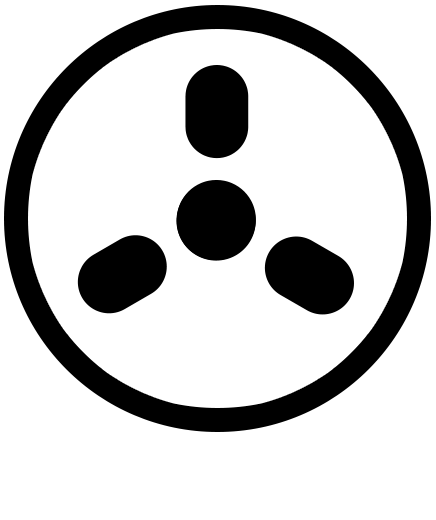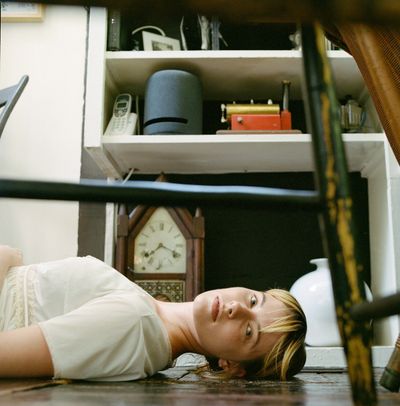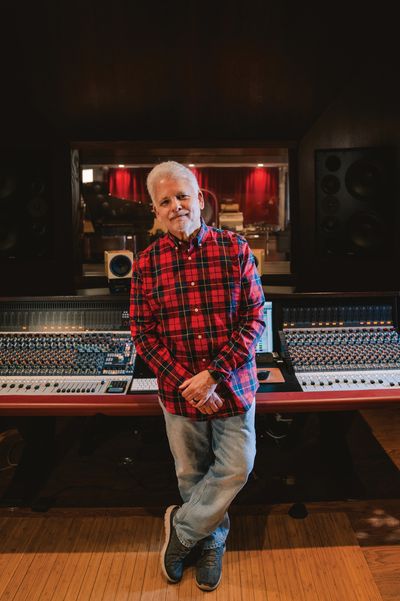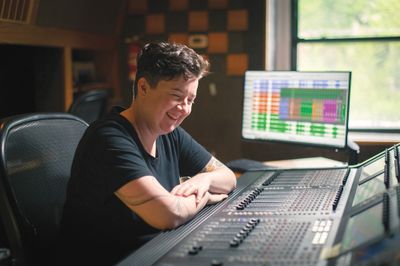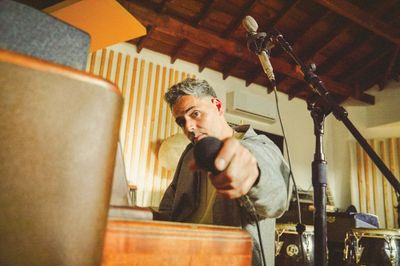How did A Ballet Through Mud come to be?
During the pandemic, I was trapped at home and came across my old lyric book from high school. I wrote everything in this book from the ages of 14 to 19 before I eventually got my Wu energy together. Raekwon [Corey Woods, of Wu-Tang] joked years ago that this book is so old it's "starting to grow hair!" [laughter] As I was going through these old lyrics about youthful exploration, I felt the need to put them to music. About 25 percent through the process, I realized that there was no need for lyrics, and I wanted to record what I had so far. First, I reached out to Will Wells, who's worked with me on a few films, but he was too busy. I also tried Adrian Younge [Tape Op #119], who was booked up as well. Finally, I connected with Christopher Dragon, the conductor of the Colorado Symphony, who had recently done the 36 Chambers of Shaolin orchestral concerts with me. [Anthony] Tony Pierce [their Chief Artistic Officer] offered to involve me with their Imagination Artist Series, which I felt was good for the children and good for the culture. I joined them, and they joined me! After I finished writing the music, it took about a year to demo it with the symphony. I traveled to Colorado twice to workshop with them before we hired dancers and the choreographer, Yusha-Marie Sorzano.
What is the storyline of the ballet?

In music there are seven modes: Ionian, Dorian, Phrygian, Lydian, Mixolydian, Aeolian, and Locrian. One of my teenage lyrics revolved around a story of six teens. One of them had never had a drink before, one had never had sex, etc., and I thought, "How could I musically express that? Once I've left the lyric alone, how can I do it in the form of a ballet?" The story follows Aeolian, our hero, going through different modes of happiness and sadness. When the feminine energy of the Ionian C major scale hits a diminished Locrian scale, and its male energy – things get deep. We, as men, can be assholes when it comes to how we treat women, even when we love them. Love can be a challenge when it's not flowing equally down a two-way street. So, Ionian becomes Aeolian, meaning she becomes that minor relative: A minor. The mission is to go through all of these different modes, and to resolve back to our original self.
What does "mud" refer to in the title?
There was a sixth-century South Asian monk, Bodhidharma, who traveled to China to teach his brand of Chan Buddhism, also known as Zen. He was born of princely descent, and, according to legend, he left behind his riches to walk from India to China. He arrived in China downtrodden, disfigured, tall, dark, and muddy. The monks were all in clean white robes with an embroidered lotus, the symbol of Buddhism. They were speaking aphorisms of the universe, wisdom, and the struggle of life. Bodhidharma wanted to join them, but they said a monk would never be defiled by mud. He simply replied that the lotus grows out of the mud. The monks became his disciples, and this is how Shaolin Temple became the home of kung fu. So, I don't make Wu-Tang if this guy doesn't make that trip! [laughs]
That's great that ballet can teach kids these concepts. Wu-Tang really is for the children, in this scenario. Did you demo the pieces with virtual instruments before working with the orchestra?

First it was just me writing it with my Korg and Yamaha keyboards, working in [Apple] Logic, plus Steinberg's Dorico and MuseScore's Studio [music notation software]. I'm kind of schizophrenic when it comes to creativity. I'll go to another machine just for inspiration or to change the pattern of thinking. I've been fortunate enough to hire staff through my television show, Wu-Tang: An American Saga, to work with me and help orchestrate. I'm able to give them MIDI sketches and they can notate them. Once we had all of A Ballet Through Mud written out with a copyist, we went to Colorado and workshopped it. We'd record it multiple times with the symphony, study the takes, and then we performed it with the dancers. I think the standing ovation didn't hurt, so I went back 90 days later, and we recorded it over a 3-day session with all of the right mics, just like Frank Sinatra used to do it.
Did mixing happen there in Colorado as well?
The Wu-Tang and Nas "N.Y. State of Mind Tour" started taking off, so that put the mixing on hold. As things go that are serendipitous in my life, after about 25 shows, Wu-Tang says they want to be able to record music while on the road. I also had my hard drives with the ballet on them, so I hired the John Lennon Educational Tour Bus from my friend, Brian Rothschild. What could be more perfect for the children than the "Imagine" bus? They had just updated the bus to do Dolby Atmos mixes and sent Pietro Rossi to engineer. He loves mixing classical music, and every night on the tour we'd get on the bus while everyone else was at the club. No one from Wu-Tang ended up coming to the bus to record, but we were able to finish mixing the ballet.
What composers were you influenced by? There are some tender Tchaikovsky-inspired pieces ("Aeolian Beauty"), as well as grandiose epic themes ("Clear Sky After the Storm" and "Winds From the East"). You have also alluded to "weird tempos" that the orchestra had to deal with.

For inspiration I would say Mozart, Bach, Stravinsky, and Leonard Bernstein. One of the first books I studied was Principles of Orchestration by Rimsky-Korsakov. I'd scanned through my copy for years, but during the creation of this project, I sat and read it every morning before I would write. As far as the tempos go, Christopher Dragon and I have a great camaraderie after the 36 Chambers arrangements, and even a lot of the orchestra members know about hip-hop. No one's offended if I don't know the word crescendo and say, "Yo, let's swish our way out of here!" We got to a point on some of the pieces where I'd say, "Let's play this part twice and then at bar 60 go back to it again" and, as long as it was within the allotted time, we'd do it. It was a union session, so you can't fuck with that. [laughs] It wasn't that it was haphazard, but I'm trying to use the language I have in the moment to communicate. Instead of putting the two dots at the end of a measure, I'd say, "Loop that shit!"
That makes more sense than a repeat symbol on a staff, and much more direct! You've also been scoring projects like the Blue Carbon documentary and three seasons of Wu-Tang: An American Saga. Are you shifting more towards Ableton Live in the studio for scoring work?
Ableton comes in handy early in the day for me. It was the first software that had the audio to MIDI capture function. I can just hook my piano to the computer with a USB and play my first instinct, and Ableton would convert that to MIDI. So, you're just flowing with your mind. Imagine if composers had that in the early days! In a way they did, because they could sit down and write in notation, but they'd have to write the right-hand melody and then stop to write out the counterpoint. Whereas nowadays my right hand could be playing [hums major triad melody] and I can start harmonizing with my left hand, and just imagine as I'm going. Then I can look back and see if it's good and do the "Mozart" part of it: Edit, transpose this up or down, make that a dotted note, and so on. But Ableton doesn't give you notation, that's the glitch. I'm lucky to have my team, including engineer Joseph Colmenero and orchestrator Ming-Hsueh Lin, aka Mitch, who help handle these things. We take that MIDI file and put it in Logic or Dorico, and Mitch can write it out properly. Dorico is great, because I can pull up a choral patch and I can start writing in a baroque style. Tempos were the biggest challenge. I would sketch in private and share with Joseph to give instructions for Mitch to orchestrate. They would come to me later and tell me it was difficult because there was no tempo. I said [whispers] "But there is a tempo…" The beautiful thing was that we could use Logic's BPM Counter to map tempos, so eventually I'd just write in Logic to save everyone a step. "Okay, he started at 80 BPM and went up to 120, and down to 40 BPM." [laughs]
You're well known as someone who doesn't use a click track. Not in an extreme way, but enough that the music breathes unconstrained to the grid. Do you know why working this way resonates with you so much?
Many times, people have told me that something sounds offbeat, and I don't hear it. Even my lyrical patterns are very unpredictable. I don't have an answer for it, but there's a trait in my family – maybe your family too – where I'm always tapping a rhythm. Even lying in bed, my feet are moving to the beat, "Left, and right, left, and right." My brother does it, my son does it, and I think that's the clock. When I'm playing music, whatever rhythm I'm feeling in my body is what I'm responding to.
Ol' Dirty Bastard's [Russell Tyrone Jones] Return to the 36 Chambers is one of my favorite productions of yours.

That album was mostly made with the Ensoniq ASR-10 sampler. I think my first 100 songs were made on that. When you'd go to make a new sequence on the ASR, the default tempo would be 100 BPM. Most other machines create tempos at 120 BPM. When I was making tracks back then, I didn't know the difference and I would force a sample into the tempo that I was feeling. So, if you take a sample like this, [hums syncopated horn melody] and put it in the 100-BPM tempo, it will speed up and cut the sound off. If you want it to fit, you have to speed the sample up or change the tempo. If I liked the tempo of the sample as is, I'd change the tempo of the beat. Or, if I'm feeling the tempo of the beat, I'm going to change the speed of the sample. So, that made unique tempo patterns on the ODB album, and also on Raekwon's Only Built 4 Cuban Linx. No one has dissected the weirdness of Return to the 36 Chambers as much as my others, but there's some crazy shit going on. Warner Bros. did a remaster of it recently. I wasn't involved, but I went in to listen. They had professors there, and the mastering engineer, and they were like, "What the fuck were you smokin', man?" It took them so long to understand it and to recall my mix that they said if you moved one fader by half a decibel the whole track would fall apart! My brain wasn't technical, it was just whatever my ear wanted. The science wasn't applied; it was more instinct.
ODB's "Raw Hide" has that great stuttering horn sample. I also read that engineer Carlos Bess would fly in whole verses on the AKAI S1000 for early Wu-Tang songs?
[hums "Raw Hide" loop, beat boxes drum fill] First of all, the highs on that are not in beat with the track. They are sped up, but the track is probably at 92 BPM. Carlos was there for a lot of the Wu-Tang sessions, and for "Proteck Ya Neck II the Zoo" we would've still been using the S1000. After that song it was mostly the ASR. For instance, in "Wu-Tang: 7th Chamber" [at 4:30] when Ol' Dirty Bastard says, "A-a-a-ah-ah are you a warrior, killer, slicing shit like a samurai?" that's a vocal flown into the sampler. I would often record vocals into the ASR because it was the first sampler to allow you the freedom to hear the track playing while you were recording. It was like an old Atari Falcon computer, where you could run audio into it while it was computing. "Shimmy Shimmy Ya" was recorded completely inside of the ASR. That's why I made the verse go backwards. Dirty was like, "Yo, that sounds dope, but I don't know if I can keep it like that. People will be like, 'How the fuck did he do that?'" They don't have to know how we did it; I love it and it sounds dope. Nobody in hip-hop at the time was that bugged out, brave, or even technologically savvy to record a vocal in the sampler and spin it backwards. Serato [Pitch 'n Time] didn't exist, so you couldn't really scratch a vocal back then.
There's also some intrigue around the "red box" you've used for drum programming. Was that not the [Ensoniq] ASR-X Pro?
In the early days, before Roland made V-Drums, Clavia (Nord) made a product called the ddrum, and I got an early prototype of it. I would hook an ASR up to it to trigger it with MIDI. It was my box of drum sounds that nobody had at the time. ddrum went out of business as Nord's other products took off. Around 1996 the V-Drum got good enough where I got it, along with an extra "brain" to carry with me at all times, and I would just hook it up to the [AKAI] MPC2000 to trigger the Roland drum sounds. You can hear this technique on "Triumph" and other songs on the album Wu-Tang Forever.
When I spoke to Prince Paul for Tape Op #158, he mentioned you contacting him to provide splits of Gravediggaz "2 Cups of Blood" for Tyler, the Creator's "LUMBERJACK."

Tyler and I have the same lawyer, so when they reached out, I said they'd need to contact Paul for that particular track. Paul and I talked about it when we spent time together about eight weeks ago. He was into the idea, because it gives you a certain kind of swagger at home when a new generation wants to jump on your track. Paul's a straightword, tell-it-like-it-is guy, and he said there was a nice ounce of joy in that.
Staten Island has dubbed the corner of Targee St. and Vanderbilt Ave. "The Wu-Tang District." What advice would you give to a fan looking to visit?
I would go in the daytime, because it can still be dangerous there; it can still pop off. If you're inspired by someone and you get the chance to walk in their footsteps, walk them. I went to China to visit the Shaolin Temple, and traveled even further to the Wudang Mountains, which was one of the toughest trips of my life, but I did it. Staten Island is a very unique place, and the population never passed 500,000. In a city like New York, that's a small handful of the population. At least take a ride on the ferry, because that 30 minutes of traveling is great for contemplation. A lot of people go to work every morning from Staten Island and come back home on that ferry. There's a lot of energy and a lot to be said about that passage.
You probably came up with a few ideas on that ferry.
A lot of ideas on that ferry…
A Ballet Through Mud and RZA as Bobby Digital: 25th Anniversary Edition are out now.
@RZA
bobbydigital.com
Sam Retzer is across the Verrazano and up the BQE a ways in Brooklyn.
samretzer.com
Photographer Brian T. Silak has done many Tape Op portraits and is at:
briansilak.com
Many thanks to Stacey DeLorenzo for making this all happen!